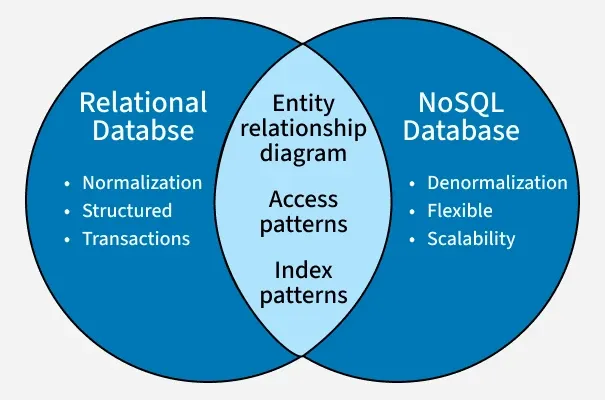Difference between Relational database and NoSQL
Last Updated : 16 Sep, 2025
Both Relational Databases (RDBMS) and NoSQL Databases are widely used, but they are built for different purposes and have distinct features. Relational Databases store data in structured tables with predefined schemas and are ideal for structured data with complex relationships. NoSQL Databases are designed for handling unstructured or semi-structured data at scale, with flexible schemas and high performance.
Relational Databases Vs NoSQL
Here is a detailed comparison based on various features:
Relational Database | NoSQL Database |
|---|
Stores data in structured tables with fixed schema (SQL) | Stores data in flexible, schema-less models (JSON, BSON, XML) |
Uses Structured Query Language (SQL) | Uses various query languages depending on model |
Vertical scaling (CPU/RAM on single server) | Horizontal scaling (adding more servers) |
Excellent for complex queries and joins | High performance with large-scale data and fast reads/writes |
Strong consistency with ACID compliance | Eventual consistency with BASE properties |
Fixed schema; changes are complex | Dynamic schema; easy to modify |
Full ACID support for multi-row transactions | Limited or simple transactions depending on model |
Banking, ERP, CRM, E-commerce | Big Data, IoT, Content Management, Real-time Analytics |
Master-slave replication | Distributed architecture; no single point of failure |
Primary, secondary, full-text indexes | Rich indexing (text, geospatial, hashed, compound) |

What is a Relational Database?
A Relational Database Management System (RDBMS) stores data in structured tables based on the relational model by E.F. Codd. It uses primary and foreign keys to maintain relationships and ensure data integrity. SQL is used to query and manage the data. RDBMSs are still the backbone of over 60% of enterprise applications.
Examples: MySQL, PostgreSQL, Oracle, SQL Server
Features of Relational Databases
- Uses SQL for querying and managing data.
- Stores structured and normalized data.
- Enforces predefined schema for consistency.
- Provides ACID properties (Atomicity, Consistency, Isolation, Durability).
- Ensures entity and referential integrity.
- Allows multi-user access with concurrency control.
- Supports normalization to reduce redundancy.
Use Cases of Relational Databases
- Banking and financial applications
- Enterprise Resource Planning (ERP)
- Customer Relationship Management (CRM)
- E-commerce platforms
What is a NoSQL
NoSQL Database stands for Not Only SQL. A NoSQL database doesn't use a table to store the data like a relational database. It is used for storing and fetching the data in the database and is generally used to store the large amount of data. It supports query language and provides better performance.
Examples: MongoDB, Cassandra, Redis, CouchDB.
Features of Non-Relational Database
- Schema-less design with dynamic data structures.
- High performance with fast read/write operations.
- Follows BASE properties (Basically Available, Soft state, Eventually consistent).
- Designed for horizontal scalability (adding more servers).
- Works with flexible formats like JSON, BSON, XML.
- Supports multiple data models: Document, Key-Value, Column-family, Graph.
- Built on distributed architecture for fault tolerance and high availability.
Use Cases of NoSQL Databases
- Big Data applications
- Real-time analytics
- Content management systems
- IoT applications
- Social and mobile apps requiring rapid scaling
Explore
Basics of DBMS
ER & Relational Model
Relational Algebra
Functional Dependencies & Normalisation
Transactions & Concurrency Control
Advanced DBMS
Practice Questions
My Profile